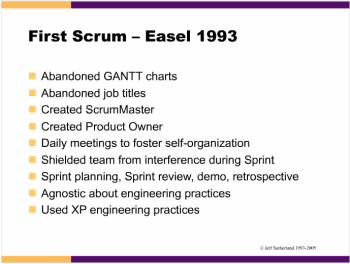|
|
Slide 30 - O primeiro Scrum
Com o entendimento de algumas destas coisas, no primeiro Scrum, em 1993, a primeira coisa que fizemos foi abandonar os gráficos GANTT. Fui até o presidente da empresa e disse: - Olha, nós temos esta idéia de um processo novo e vamos construir todo este novo produto usando esta idéia, e você precisa nos apoiar. -- e eu disse – Antes que eu o descreva para você, deixe-me perguntar... Você está no mercado há 26 anos, dirigiu várias empresas diferentes, centenas, talvez milhares de projetos, onde sempre foram apresentados a você gráficos GANTT para os planos, certo? O CEO diz: - Nenhum! Nenhunzinho! Eu disse: - Quantos destes projetos foram entregues no prazo? Ele nunca recebeu um projeto no prazo. Então eu disse: - Bem, este projeto no qual estamos trabalhando, temos que entregá-lo em seis meses, é um diferencial importante para a empresa. Se não entregarmos este projeto no prazo, a sobrevivência da empresa está em risco. Que tal se eu garantir que o processo gerará a entrega no prazo? Nós vamos entregá-lo em seis meses. Ele disse: - Gostei disto! Eu disse, “Muito bem! Você não irá receber nenhum gráfico GANTT. Não daremos a você nenhum deles. O que eu darei a você são iterações mensais e ao final de cada mês você será capaz de sentar-se, avaliar o código funcional, brincar com ele em um terminal e julgar se o produto está indo na direção que você imagina que atenderá o mercado”. E completei: “Isto será muito mais preciso que um gráfico GANTT, especialmente um que não mostra nada até o final do projeto. Estes são gráficos GANTT particularmente desastrosos. Não vamos fazer isto!”. A segunda coisa que fizemos foi abolir todos os títulos profissionais, porque eles simplesmente atrapalham o caminho. Bem, faremos uma única exceção. Teremos membros da equipe técnica e membros seniors da equipe técnica. E apenas serão membros seniors aqueles que sabem tanto que são aclamados universalmente como gurus. Daremos a estes a bênção de ser um membro senior da equipe técnica. Nós enfatizamos, porém, que para o avanço de sua carreira e seu currículo, você pode inventar o título profissional que quiser. Você pode até tê-lo impresso em um cartão de visitas. Só é preciso que a equipe concorde que este título reflete o seu trabalho. Tem que refletir o que você faz. Assim, cada um tinha seus cartões de visitas e estavam felizes com isto. Nós criamos, então, o ScrumMaster. Não consigo lembrar-se como surgiu este nome, mas o líder de uma equipe Scrum é o ScrumMaster. Seu nome era John Scumniotales. Hoje ele é o CTO de uma empresa em Redmond, Washington. Nós criamos o Product Owner, uma pessoa na empresa que era da área de marketing de produtos. Ele estava trabalhando com o cliente todo o tempo. Ele era o proprietário do plano de negócios, do retorno sobre investimentos e das informações dos clientes. O projeto Quattro Pro nos incentivou às reuniões. Não queríamos reuniões longas. As fizemos pequenas, de 15 minutos. A outra coisa que eu disse ao CEO foi: “Você não pode incomodar os desenvolvedores durante cada iteração. Eu não quero sequer que você fale com eles”. Hoje, em minha empresa, o CEO realmente fala com os desenvolvedores o tempo todo. Ou seja, nós ultrapassamos esta fase. Mas naquela época tínhamos que ter regras estritas para que o Scrum funcionasse. Tivemos uma reunião de planejamento do Sprint, tipicamente meio dia em que varríamos o product backlog e mais meio dia para a definição de tarefas. Passamos por cada incremento mensal, pela revisão do Sprint, uma demonstração, uma retrospectiva... Todas as práticas aplicadas no Scrum hoje foram usadas no primeiro Scrum. Éramos agnósticos quanto a práticas de engenharia. Especificamente, queríamos criar um mecanismo que cada pessoa poderia começar em dois dias. E isto os apresentaria a um mecanismo de melhoria de qualidade que viria à superfície nas práticas de engenharia e seria priorizado e utilizado. O primeiro time usou todas as práticas de engenharia do XP, mesmo que o XP não existisse naquele tempo.
- Hey, we've got this idea for a new process and we´re gonna build this new product using it, and I need you to support it. -- and I said -- Before I describe it to you, you've been in this business 25 years, you've run a number of different companies, you know, hundreds of projects, maybe even thousands, and you've always been presented GANTT charts for plans, right? The CEO says: - None! Not a one! I said: - How many of those projects ever delivered on time? He never had one. So I said: - Well, this project we are on, we gotta deliver it in six months, it's a company breaker. If we don't deliver this project on time the company survival is at risk. What if I guarantee the process that delivers on time? We are gonna deliver it in six months. He said: - I'd like that! I said, “Ok! You're not gonna get any GANTT charts. We're not gonna give you any GANTT charts. What I'm gonna give you is monthly iterations and at the end of every month you'll be able to sit down, you'll be able to look at working code, you'll be able to play with it yourself in a terminal and you will be able to judge whether this product is moving along in a way that you think it's gonna meet the market.”. And I said “that will be much more accurate than a GANTT chart, particularly one that doesn't show you anything until the end of the project. Those are particularly disastrous GANTT charts. We are not gonna do that.” The second thing we did was, we needed to abolish all of the job titles, because they just get in the way. Well, we're gonna make one exception. We're gonna have members of the technical staff and we are gonna have senior members of the technical staff. And the only ones that will be senior members of technical staff are the ones who know so much it's universally acclaimed that the person is a guru. We'll give him the blessing of senior member of technical staff. We did say, for your career advancement and, you know, your resume, you can make up any business title you want. And you can even put it on a business card. You just have to get the team to agree that it reflects your work. It's gotta reflect what you do. So everybody had their own business cards, they were happy with that. We then created the ScrumMaster. I can't remember how this title came up but the leader of the Scrum team is the ScrumMaster. His name was John Scumniotales, he's the CTO of a company out in Redmond Washington right now. We created a Product Owner, a guy in that company out of product marketing. He was out working with the customer all of the time. He owned the business plan, the return on investment, and the customer input. The Quattro Pro project kicked us into meetings. We didn't want long meetings, we made them short, 15 minutes. The other thing I said to the CEO is that “you can't mess with the developers during that iteration. I don't even want you talking to them”. Right now, in my company now, the CEO does talk to them all of the time. So, we moved beyond that. But then we had to put some strict rules in place to make the Scrum work. And we had a Sprint planning meeting, typically a half day to go through the product backlog and then a half day to the get task laid out. We went through the monthly increment, we had the Sprint review, a demo, a retrospective... All the practices that we do on Scrum today we did in that first Scrum. We were agnostic about engineering practices. Specifically, we wanted to create a mechanism that anyone could start in two days. And that would them introduce a quality improvement mechanism that would surface that engineering practice and it would be prioritized and worked on. And the first team used all the XP engineering practices even though XP didn't existed at the time.
|






